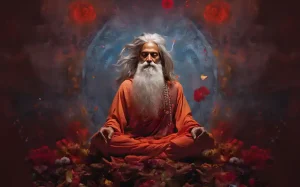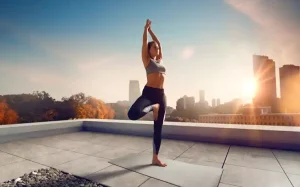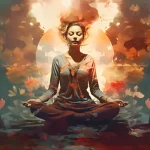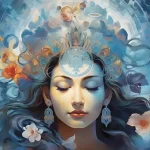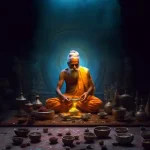
Yoga, a time-honored practice originating in ancient India, stands as a holistic system that nurtures physical, mental, and spiritual well-being. Rooted in a quest for harmony between the mind and body, it offers a path to aligning with the profound realities of existence. With diverse schools spanning Hinduism, Buddhism, and Jainism, the history of yoga spans centuries and encompasses a rich tapestry of traditions. Philosophical insights and practical applications have shaped the evolution of yoga, from its early references in ancient texts like the Rigveda to its modern interpretation.
Essence of Yoga
Yoga, an ancient and profound system, embodies physical, mental, and spiritual well-being. Originating in India, it was practised by sages seeking harmony between mind and body and the realisation of ultimate existence. With diverse practises in Hinduism, Buddhism, and Jainism, yoga’s history spans centuries. References appear in ancient texts like the Rigveda and Upanishads, and their modern meaning emerged around the 5th to 3rd centuries BCE. Developed systematically during India’s ascetic movements, yoga gained prominence as a Hindu philosophical school. Two theories—linear and synthesis—debate its origins, with the latter favoured in Western scholarship. In the West, “yoga” often denotes a modern form focused on physical fitness and relaxation, popularised by figures like Swami Vivekananda.
Ancient Origins and History of Yoga
The Sanskrit term योग (yoga) originates from the root yuj (युज्), meaning “to attach, join, harness, yoke,” akin to the English word “yoke.” The Rigveda’s hymn 5.81.1 interprets the earliest trace of “yoga” as signifying “yoke” or “control.” Pāṇini suggested yoga’s origin from two roots: yujir yoga (to yoke) or yuj samādhau (“to concentrate”). Traditional commentators align with the Yoga Sutras, affirming yuj samādhau (to concentrate) as an accurate etymology. Following Pāṇini, Vyasa equates yoga with samadhi (concentration) in the Yoga Sutras (2.1), where kriyāyoga represents practical “union with the supreme” during daily responsibilities, earning practitioners the titles of yogi or yogini.

Yoga is a spiritual discipline and subtle science, that harmonises mind and body. Derived from the Sanskrit root ‘Yuj,’ meaning ‘to join’ or ‘to unite,’ it unites individual consciousness with Universal Consciousness. This oneness brings harmony between Man, Nature, and the universe, leading to Self-realisation and liberation from suffering. Yoga encompasses a variety of methods for realising this union and achieving mastery over one’s destiny. Its ancient roots trace back to the Indus Saraswati Valley civilization, catering to both material and spiritual upliftment. Fundamental humane values are intrinsic to Yoga Sadhana.
History of Yoga
The history of Yoga dates back to the earliest days of human civilization. Its roots go back thousands of years, before the birth of religions or belief systems. In ancient stories, Shiva is portrayed as the first yogi and Guru. A long time ago, near a Himalayan lake called Kantisarovar, Adiyogi shared his deep knowledge with the legendary Saptarishis, or “seven sages.” These sages spread this powerful yogic wisdom to various parts of the world, such as Asia, the Middle East, Northern Africa, and South America. It’s interesting that experts have noticed striking similarities in ancient cultures worldwide. However, India is where Yoga flourishes the most. Agastya, one of the sages, journeyed across the Indian subcontinent, shaping a way of life centred around yoga principles.
Ancient Evidence of Yoga

The ancient seals and fossil remains from the Indus Saraswati valley civilization show images of people practising Yoga. These images suggest that Yoga was present in ancient India. Some symbols, like phallic shapes and idols of the mother Goddess, hint at Tantra Yoga. Yoga can also be found in various traditions: folk practises, the Indus Valley civilization, Vedic and Upanishadic teachings, Buddhist and Jain practises, philosophical schools, epics like the Mahabharata and Ramayana, and the spiritual paths of Shaivas, Vaishnavas, and Tantric practitioners. Additionally, there’s a fundamental or pure form of Yoga seen in the mystical traditions of South Asia.
Surya Namaskara

In ancient times, a spiritual guide (a guru) directly taught Yoga and people held its significance in high regard. They integrated it into worship (Upasana) and daily routines. The sun held great importance during the Vedic era. The practise of ‘Surya Namaskara,’ a series of poses dedicated to the sun, might have been developed later and influenced by this reverence. Breathing exercises (Pranayama) were part of daily rituals and offerings. Even before the Vedic period, people practiced Yoga, but the wise Sage Maharshi Patanjali organized and explained the existing Yoga practices, their meanings, and their knowledge in his Yoga Sutras. Following Patanjali, many other Sages and Yoga Masters contributed to the preservation and advancement of Yoga through their documented teachings and practises.
Historical evidences of Yoga

We can find proof of Yoga’s existence before the Vedic period (around 2700 B.C.) and up to the time of Patanjali. The knowledge about Yoga practises and related teachings from this time comes from various sources, such as the Vedas (4 ancient texts), Upanishads (108 texts), Smritis (scriptures), teachings from Buddhism and Jainism, the work of Panini, two great Epics, and 18 Puranas (mythological texts).
500 BC–800 AD: The Golden Age of Yoga
The Classical Era, spanning roughly from 500 BC to 800 A.D., stands as a highly significant and productive phase in Yoga’s history. During this time, Vyasa offered insights through commentaries on the Yoga Sutras and the Bhagavad Gita, among other texts. India’s prominent spiritual leaders, Mahavir and Buddha, took centre stage. Mahavir introduced the concept of the Pancha Mahavrata (Five Great Vows), while Buddha taught the Ashta Magga (Eightfold Path), both considered early forms of yoga practise. The Bhagavad Gita extensively elaborates on Gyan Yoga, Bhakti Yoga, and Karma Yoga. These three yogic paths remain pillars of wisdom, bringing serenity to people’s lives even today. Patanjali’s Yoga Sutra, known for outlining the eight-fold path of yoga, also contributed to this era’s rich yoga tradition.
800 A.D. – 1700 A.D.
The important Vyasa commentary on the Yoga Sutra was created in this period. It highlighted the role of the mind, and it was evident through yoga practice. The practice showed that both mind and body can be controlled for inner balance. This era from 800 to 1700 A.D., is called the Post Classical period. It was a time when teachings from prominent figures like Adi Shankracharya, Ramanujacharya, and Madhavacharya held great sway. The teachings of Suradasa, Tulasidasa, Purandardasa, and Mirabai also added to this period’s significance. Natha Yogis from the Hathayoga Tradition, including Matsyendaranatha, Gorkshanatha, Cauranginatha, Swatmaram Suri, Gheranda, and Shrinivasa Bhatt, played a key role in popularizing Hatha Yoga during this time.
1700–1900 A.D.
From 1700 to 1900 A.D., we enter the Modern period of yoga’s development. During this time, important yoga teachers like Ramana Maharshi, Ramakrishna Paramhansa, Paramhansa Yogananda, and Vivekananda played a significant role in advancing Raja Yoga. This era saw the flourishing of Vedanta, Bhakti yoga, and Hatha yoga, including traditions like Nathayoga. Key concepts like Shadanga-yoga, Chaturanga-yoga, and Saptanga-yoga were important in Hatha-yoga practise. In modern times, yoga has gained widespread recognition for its health benefits. Influential figures such as Swami Shivananda, Shri T. Krishnamacharya, Swami Kuvalayananda, Shri Yogendara, Swami Rama, Sri Aurobindo, Maharshi Mahesh Yogi, Acharya Rajanish, Pattabhijois, BKS. Iyengar, and Swami Satyananda Sarasvati have helped spread yoga worldwide through their teachings.
Clarifying Misunderstandings
Many people associate yoga mainly with Hatha Yoga and physical postures (asanas). However, it’s important to note that in the Yoga Sutras, only three sutras are dedicated to asanas. Essentially, hatha yoga prepares the body to handle greater energy levels. It begins with the body, then focuses on the breath, the mind, and finally the inner self. While yoga does contribute to physical and mental well-being, its ultimate purpose goes beyond that. Yoga aims to align our individual existence with the universe, enhancing our perception and achieving profound harmony.”
Yoga’s Teaching Lineages
Yoga isn’t tied to any specific religion, belief, or community. It’s seen as a tool for inner well-being. Anyone who practises yoga can benefit from it, regardless of their faith, background, or culture. Traditional Yoga Paths: The various Philosophies, Traditions, lineages, and Guru-student teachings of Yoga have given rise to different Traditional Yoga Paths such as Jnana-yoga, Bhakti-yoga, Karma-yoga, Dhyana-yoga, Patanjala-yoga, Kundalini-yoga, Hatha-yoga, Mantra-yoga, Laya-yoga, Raja-yoga, Jain-yoga, Bouddha-yoga, and more. Each path has its own principles and practises that lead to the ultimate goals and objectives of Yoga.
Yogic Practises for Health and Wellness
Yoga offers various practises for both the mind and body. Some widely practised Yoga techniques include: Yama and Niyama, Asana, Pranayama, Pratyahara, Dharana, Dhyana (Meditation), Samadhi and Samyama, Bandhas and Mudras, Shat-karmas, Yukta-ahara, Yukta karma, and Mantra Japa.Yama refers to restraints, while Niyama involves observances. These are important foundations for Yoga practises. Asanas are postures that help stabilise both the body and mind. By adopting different physical and mental patterns, you learn to maintain a steady body position and awareness of your body’s structure for a significant period of time.
Breath Awareness and Regulation (Pranayama)
Pranayama is about becoming aware of your breath and then intentionally controlling how you breathe. This is important because breathing is vital to our existence. Pranayama helps you become more aware of your mind and gain better control over it. At the beginning, you focus on being aware of how your breath flows in and out through your nostrils, mouth, and other openings in your body. You also notice the paths it takes inside and outside your body. Later on, this practise gets more specific. You start regulating your breath by controlling how you inhale (svasa), how your body fills with air (puraka), how you hold that breath (kumbhaka), and how you exhale (rechaka). This controlled breathing helps you achieve better control over your mind and body.
Meditation (Dhyana)
Pratyahara is when you disconnect your awareness from your senses, allowing you to still stay in touch with the world around you but not get overwhelmed by it. Dharana means focusing your attention within your body and mind, like concentrating on one thing. Meditation (Dhyana) is when you deeply think about something or focus your attention inside your body and mind. Samadhi is when everything comes together and you feel fully connected. Bandhas and Mudras are practises that go along with controlled breathing. They involve certain body movements and positions that help you gain even more control over your breath and mind. Shat-karmas are ways to cleanse your body, removing toxins. Yuktahara means eating the right kinds of food to stay healthy. But the most important part of Yoga practise is Meditation (Dhyana), which helps you understand yourself better and reach a higher level of awareness.
Conclusion
Yoga works on different parts of you: your body, mind, emotions, and energy. This leads to four main types of Yoga: karma yoga, which involves your body; bhakti yoga, which involves your emotions; gyana yoga, which involves your mind and intellect; and kriya yoga, which involves your energy. Each person is a mix of these four aspects. “Ancient teachings emphasise the need to learn Yoga from a Guru.” Yoga Education: Traditionally, families and wise people taught Yoga (similar to education in schools). Seers (Rishis, Munis, and Acharyas) taught it in Ashramas (like monasteries). Yoga Education aims to help you become a better person. It believes that a balanced, truthful, and good person benefits themselves, their family, society, nation, and the world. Yoga education focuses on your inner self. Various traditions and texts explain how to improve your inner self, and the method for this is called ‘Yoga’.
